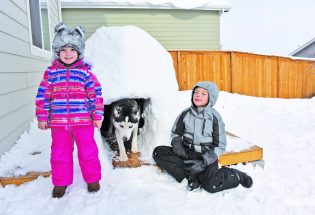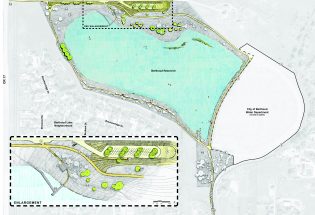Air quality on the Front Range fails EPA standards

By Amber McIver-Traywick
The Surveyor
The U.S. Environmental Protection Agency (EPA) is proposing to reclassify the Denver Metro and the Northern Front Range, including Berthoud, as an ozone non-attainment area. The region did not meet the standards set by the 2008 National Ambient Air Quality Standard (NAAQS) by the specified deadline and will now be reclassified from a Moderate to a Serious non-attainment area. EPA will be accepting public comment on the proposed action for a 30-day period beginning on Aug. 15, and will hold a public hearing at the agency’s regional office in Denver on Sept. 6.
“EPA is proposing this action as required by the Clean Air Act,” said EPA Regional Administrator Gregory Sopkin. “We will continue to support the state as they revise plans and implement new measures that will reduce ozone-forming emissions across the many sources contributing to air quality impairment along Colorado’s Front Range.”
Since 2016 Denver and the northern Front Range area have been classified as a moderate non-attainment area with the situation worsening in recent years. The decision to go from moderate to severe was the result of an evaluation of substantial amounts of data collected by the EPA between 2015 and 2017. Under the Clean Air Act (CAA), regions that did not reach standards in a timely manner are reclassified. The CAA, a federal law designed to control air pollution on a national level, is widely considered one of the most influential and comprehensive environmental laws in the world.
States with a downgraded status are required to submit a State Implementation Plan (SIP) which is set into motion by a set of enforceable rules and programs for non-attainment areas to reach attainment status as soon as possible, but in no more than five years, based on the severity of the air pollution and the difficulty posed by obtaining cleaner air. In general, if the EPA finds a violation has occurred, the agency can issue an order requiring the violator to comply, issue an administrative penalty up to $37,500 per day, or sue the violator in court.
Some serious area requirements would be effective as soon as this action is finalized, such as a lower threshold for permitting large sources like motor-vehicle exhaust, industrial emissions, and chemical solvents. The proposal would set a new deadline of July 20, 2021, for the Denver and the Front Range area to attain the 2008 ozone standards.
According to research done by the EPA, the top three contributors to greenhouse gases comprise 34% electric generation, 22% vehicles of all sizes, and 15% industry. The CAA sets air-quality standards for six common pollutants; including carbon monoxide and ground-level ozone – a primary component of smog, lead, nitrogen oxides, particulate matter, and sulfur dioxide. The pollutants can harm individual’s health as well as the environment, and cause property damage. Particle pollution and ground-level ozone are the most widespread health threats. Ozone affects the lungs and can make preexisting health issues like asthma and chronic bronchitis worse.
Air quality alerts and Ozone Action Alert Days are made public by the Colorado Department of Public Health & Environment and have been a common occurrence for much of the summer.
For more details about the EPA’s proposed actions visit epa.gov/ground-level-ozone-pollution/2008-ozone-national-ambient-air-quality-standards-naaqs-nonattainment.
- August, 23 2023

First West Nile Virus Death Confirmed...
Special to the Surveyor The Larimer County Department of Health and Environment (LCDHE) has confirmed...
- June, 13 2014

Despite growth, Berthoud Day retains ...
By John Gardner The Surveyor Steve Jorgenson, aka Captain America, salutes...
- December, 07 2019

Igloo Sculpting
Photo by Eric Wallen Evelina and Dominic Wallen, along with Sky the Siberian Husky, play...
- June, 11 2020

Berthoud Reservoir and Waggener Farm ...
File photo - Berthoud Reservoir concept drawing presented to the Board of Trustees on June...
- April, 16 2015

Commentary: An open letter to the com...
By Bob Kerrigan Thompson Valley School District Board of Education President As your Thompson School...
- December, 31 2020

Larimer County “Level Up”...
Last Wednesday afternoon, Larimer County received word from the Colorado Department of Public Health and...

POLICEBLOTTER
Community News
Northern Water sets C-BT quota at 70% for 2024
Community News

Emotions run high during Revere Property hearing
Community News
Snowpack at 119% above normal
Community News

Karspeck to serve third term as Berthoud mayor
Community News

OPINION – No bitchin’ allowed
Community News
Roy Tripi to become principal of BHS on July 1
Community News
COMMUNITY CALENDAR:
Community Calendar – add an event
Homestead Fine Art Gallery First Fridays OPEN HOUSE
03 May 4:00 PM - 7:00 PM
Homestead Fine Art Gallery First Fridays OPEN HOUSE
07 Jun 4:00 PM - 7:00 PM
Homestead Fine Art Gallery First Fridays OPEN HOUSE
05 Jul 4:00 PM - 7:00 PM
Homestead Fine Art Gallery First Fridays OPEN HOUSE
02 Aug 4:00 PM - 7:00 PM
Homestead Fine Art Gallery First Fridays OPEN HOUSE
06 Sep 4:00 PM - 7:00 PM
Homestead Fine Art Gallery First Fridays OPEN HOUSE
04 Oct 4:00 PM - 7:00 PM

